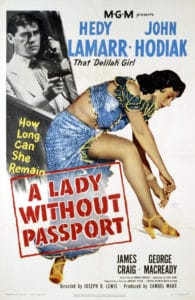M-G-M THRILLS!
Such a nondescript tagline should let you know right away that all is not well with MGM’s 1950 film A Lady Without Passport. Additional language from promotional collateral at the time includes lines like, “How long can she remain,” and “That ‘Delilah’Girl,” with both being references to the film’s headline star, Hedy Lamarr.
Lamarr in 1950 was coming off perhaps her greatest career triumph in Cecil B. DeMille’s Samson and Delilah from the previous year. The plethora of strong resulting offers combined with the creative freedom an in demand contractless starlet had should have resulted in another strong effort.
Sadly it isn’t to be so. Perhaps driven by a desire to return to her former studio triumphant, Lamarr opted to take MGM’s offered role in A Lady Without Passport, though not without hold Louis B. Mayer hostage a bit first. Most reports claim that in return she got a salary of $90,000 for her appearance in the film.
Her role is that of would-be refugee Marianne Lorress, a native of Budapest and survivor of the Nazi concentration camps. She has been working towards emigrating to the United States, but finds herself trapped in Cuba without papers or much likelihood of achieving her dream.
She comes across a shady character named Palinov (played by George Macready). Palinov owns a local watering hole which also serces as a cover for his other business- smuggling folks into the States at $1,000 a head.
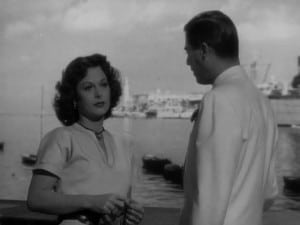 Almost concurrently with her introduction with Palinov she also meets fellow refugee Peter Karczag (John Hodiak), another who calls Budapest home. What Lamarr doesn’t know is that Peter is really an INS agent on a mission to smoke out Palinov’s ring and shut it down, using Lamarr as the foil.
Almost concurrently with her introduction with Palinov she also meets fellow refugee Peter Karczag (John Hodiak), another who calls Budapest home. What Lamarr doesn’t know is that Peter is really an INS agent on a mission to smoke out Palinov’s ring and shut it down, using Lamarr as the foil.
But to no one’s surprise two things happen. First Peter is found out buy Palinov’s gang and roughed up a bit. Secondly, he falls for Lamarr. The couple wander around Cuba for a bit, but their romance never seems to click. While Hodiak seems up to the task, Lamarr seems stiff and frigid, almost as if she’d rather be on her way to identify a body at a morgue than spend time with her love interest.
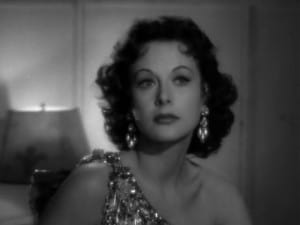 Lamarr finds out that Hodiak is in fact an INS agent and takes the next clandestine flight out with Palinov, his pilot, and a few other refugees. Their destination is South Carolina, but they are identified during a refueling stop in Florida. Rather than finish refueling they take off in a rush and almost immediately have to begin to put the plane down due to lack of fuel. After the expected crash Palinov escapes across the everglades with Lamarr as his hostage.
Lamarr finds out that Hodiak is in fact an INS agent and takes the next clandestine flight out with Palinov, his pilot, and a few other refugees. Their destination is South Carolina, but they are identified during a refueling stop in Florida. Rather than finish refueling they take off in a rush and almost immediately have to begin to put the plane down due to lack of fuel. After the expected crash Palinov escapes across the everglades with Lamarr as his hostage.
Pete tracks them down in the swamps and after a final confrontation is reunited with Marianne.
A Lady Without Passport feels like the B movie it almost is. Only the presence of Lamarr and a suitably appropriate score by David Raksin keep it from taking up that mantle. Even with a run time of only seventy-three minutes, the plot simply isn’t developed enough to sustain anything nearly as substantial.
Though Lamarr takes top billing, her character doesn’t really have much to do and the picture quickly becomes Hodiak’s. For a needy concentration camp survivor she seems to be perhaps too beautiful and have too many exquisite dresses to make her role plausible.
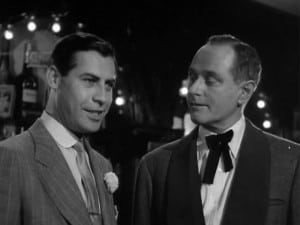 Palinov has the most potential to add depth, but here to Macready isn’t given much to work with. We never learn of his motivations or ulterior motives. Perhaps there are none and the only motivation is money, but like the remainder of the cast Palinov goes no further than the cardboard outline which was sketched for him.
Palinov has the most potential to add depth, but here to Macready isn’t given much to work with. We never learn of his motivations or ulterior motives. Perhaps there are none and the only motivation is money, but like the remainder of the cast Palinov goes no further than the cardboard outline which was sketched for him.
Poverty Row director Joseph H. Lewis takes the helm behind the camera and does add as much atmosphere as he can. Though surely shot by a second unit, we get a good view of Cuba complete with a full retinue of architectural, musical and cultural stimuli. He also provides a truly unique shot of the survivors of the plan crash scurrying into their life rafts. The shot is purely from overhead, almost as if watching ants from above and is very well done. (The crash itself, however, is a wondrously awful piece of modelry.)
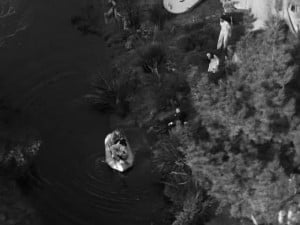 Lewis, always known as a director who almost always offered style over substance, also adds what I will call noir-light. Noir because there are lots of heavy shot filled with darkness and interesting shadows. The film provide a wonderfully atmospheric environment. Light because true noir also requires suspense, drama, conflict, something to drive the action. Nothing approaching any of the above comes into A Lady Without Passport. Also in the best noirs everyone has their flaws and nobody truly wins at the end. Here it is almost explicitly stated that Pete gets his girl at the end.
Lewis, always known as a director who almost always offered style over substance, also adds what I will call noir-light. Noir because there are lots of heavy shot filled with darkness and interesting shadows. The film provide a wonderfully atmospheric environment. Light because true noir also requires suspense, drama, conflict, something to drive the action. Nothing approaching any of the above comes into A Lady Without Passport. Also in the best noirs everyone has their flaws and nobody truly wins at the end. Here it is almost explicitly stated that Pete gets his girl at the end.
After A Lady Without Passport Hedy Lamarr’s career resumed its slow decline and she worked sporadically for the balance of the 1950s before retiring after her last role in 1958’s The Female Animal. Joseph H Lewis, perhaps the other biggest name from the picture, saw a similar fate. After the film he returned to the B pictures from which he came. He too however was out of pictures by the end of the decade, though he later had renewed success in television. He is best known for his role in directing fifty-one episode of TV’s The Rifleman.
